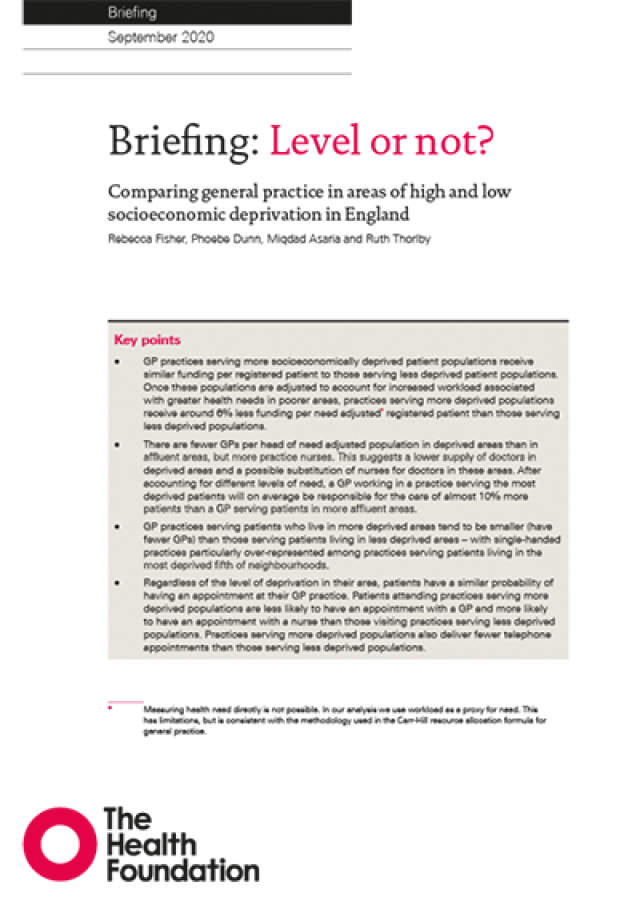Level or not? Comparing general practice in areas of high and low socioeconomic deprivation in England
September 2020

Key points
-
GP practices serving more socioeconomically deprived patient populations receive similar funding per registered patient to those serving less deprived patient populations. Once these populations are adjusted to account for increased workload associated with greater health needs in poorer areas, practices serving more deprived populations receive around 7% less funding per need adjusted* registered patient than those serving less deprived populations.
-
There are fewer GPs per head of need adjusted population in deprived areas than in affluent areas, but more practice nurses. This suggests a lower supply of doctors in deprived areas and a possible substitution of nurses for doctors in these areas. After accounting for different levels of need, a GP working in a practice serving the most deprived patients will on average be responsible for the care of almost 10% more patients than a GP serving patients in more affluent areas.
-
GP practices serving patients who live in more deprived areas tend to be smaller (have fewer GPs) than those serving patients living in less deprived areas – with single-handed practices particularly over-represented among practices serving patients living in the most deprived fifth of neighbourhoods.
-
Regardless of the level of deprivation in their area, patients have a similar probability of having an appointment at their GP practice. Patients attending practices serving more deprived populations are less likely to have an appointment with a GP and more likely to have an appointment with a nurse than those visiting practices serving less deprived populations. Practices serving more deprived populations also deliver fewer telephone appointments than those serving less deprived populations.
-
GP practices serving more deprived patient populations on average earn fewer quality and outcomes framework (QOF) points, have worse Care Quality Commission (CQC) ratings and lower patient satisfaction scores than practices serving less deprived populations. These measures of assessing quality may themselves be affected by deprivation. Further research is needed across other aspects of quality to explore whether patients living in more deprived areas receive a systematically lower quality of care.
In this briefing we use publicly available data to explore the current relationship between population need and supply in general practice, seeking to answer the question: how does general practice compare in areas of higher and lower socioeconomic deprivation in England? Our analysis contributes to an understanding of the extent to which the inverse care law persists in general practice today.
To form a rounded view of general practice we look across the following areas:
-
First, we consider the variation in funding between different providers.
-
This impacts on supply: the number and skills mix of the staff employed in a practice, the infrastructure and equipment available, and information systems used – this also includes the location of the practice.
-
These elements influence access: the number and type of appointments that can be offered, and the staff that provide them.
-
And in turn the quality of services provided to patients, as well as the practice’s ability to coordinate care for their patients.
We provide several considerations for policy that could help to level-up general practice in England. Additional effort will be needed to ensure that more GPs (to be recruited following government pledges) are distributed to areas of high deprivation. We also call for a review of funding allocations to general practice in England, which would consider funding for Primary Care Networks and the underlying resource allocation formula, Carr-Hill.
Cite this publication
Notes
* Measuring health need directly is not possible. In our analysis we use workload as a proxy for need. This has limitations, but is consistent with the methodology used in the Carr-Hill resource allocation formula for general practice.
Further reading
Work with us
We look for talented and passionate individuals as everyone at the Health Foundation has an important role to play.
View current vacanciesThe Q community
Q is an initiative connecting people with improvement expertise across the UK.
Find out more


